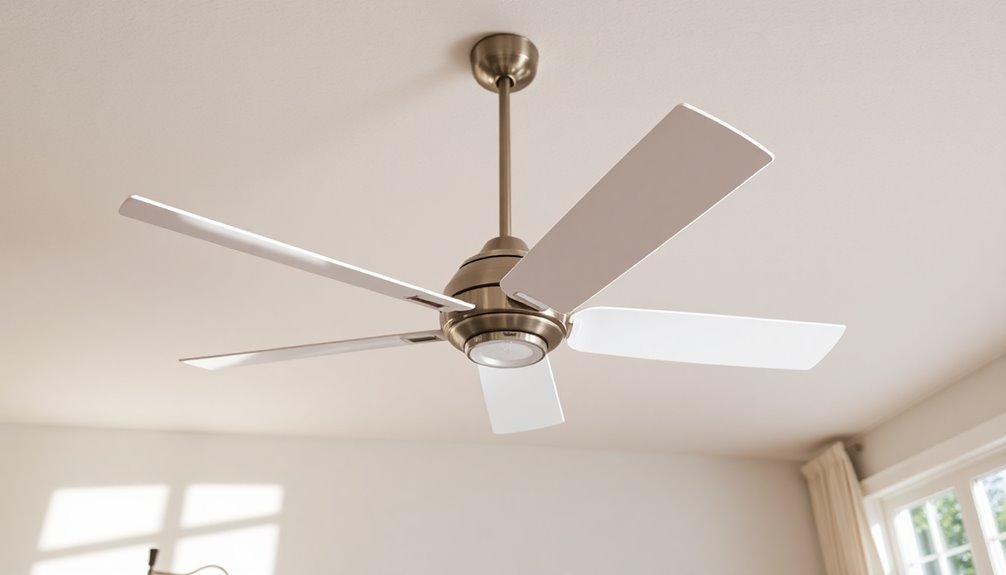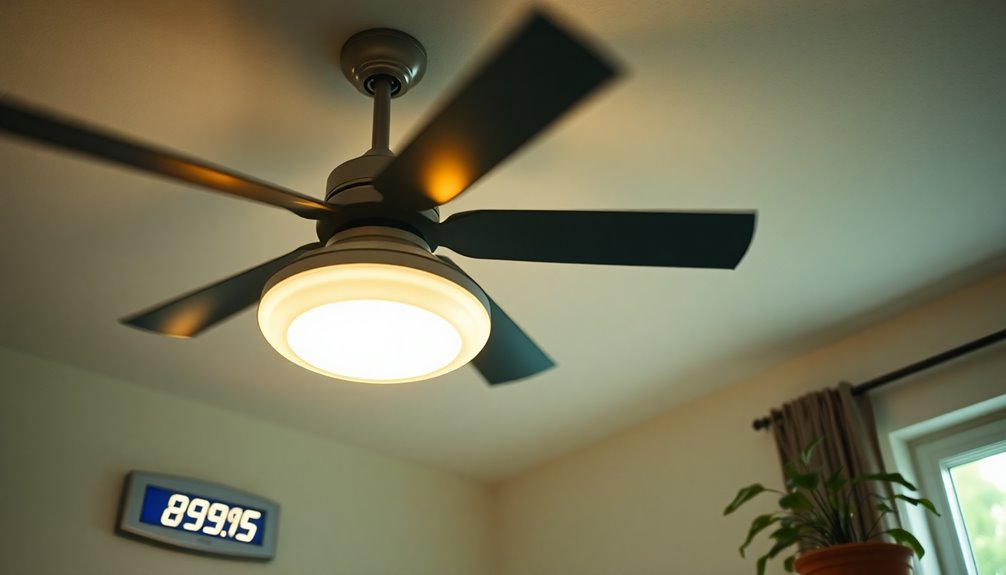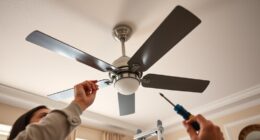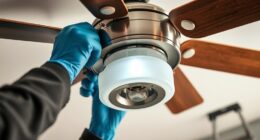Ceiling fans don't directly reduce humidity levels in your home. Instead, they improve comfort by creating airflow that supports evaporation from your skin, making it feel cooler. By circulating air, fans help prevent stagnant conditions that can lead to higher humidity levels. However, if you're looking to greatly lower humidity, you'll need a dehumidifier, which can reduce levels by 30-50%. Combining fans with dehumidifiers can optimize indoor comfort. If you're curious about other ways to manage humidity, you'll find some effective strategies ahead.
Key Takeaways
- Ceiling fans do not directly reduce humidity levels; they circulate air to enhance evaporation from skin, creating a cooling effect.
- While fans help prevent stagnant air, they do not remove moisture like dehumidifiers do.
- Fans can support humidity control by promoting air circulation and facilitating cross-ventilation when windows are open.
- Running fans in humid areas, such as kitchens and bathrooms, can help disperse moisture but won't significantly lower humidity levels.
- For effective humidity reduction, combine ceiling fans with dehumidifiers and proper ventilation strategies.
Understanding Humidity Basics
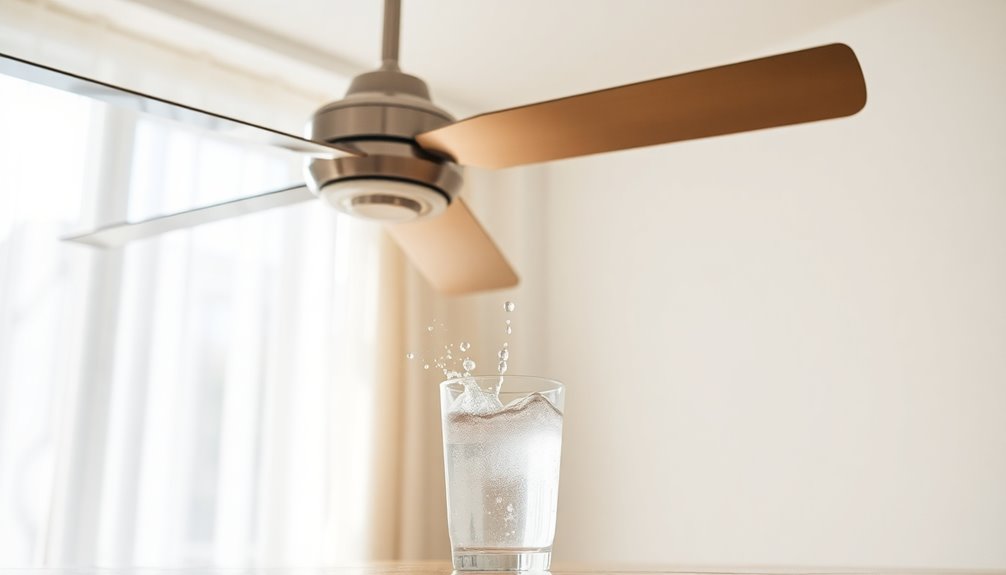
Humidity plays an essential role in your indoor environment, as it measures the moisture content in the air. When you think about humidity levels, keep in mind that they're typically expressed as a percentage. Ideally, you want indoor humidity levels between 30% and 50%.
When they exceed 50%, you may experience discomfort, mold growth, and even respiratory issues.
Relative humidity is influenced by temperature; warmer air can hold more moisture than cooler air. This means you need to manage humidity effectively to maintain a comfortable space.
To do this, you can measure humidity levels using a hygrometer, which helps you monitor indoor air quality.
To reduce humidity, consider utilizing methods like ventilation, air conditioning, or dehumidifiers. These tools work together to create a balanced indoor environment.
For instance, turning on a dehumidifier can actively draw moisture from the air, preventing the growth of mold and ensuring your indoor space remains comfortable.
Understanding these basics of humidity will empower you to take control of your environment and improve your overall well-being.
How Ceiling Fans Work
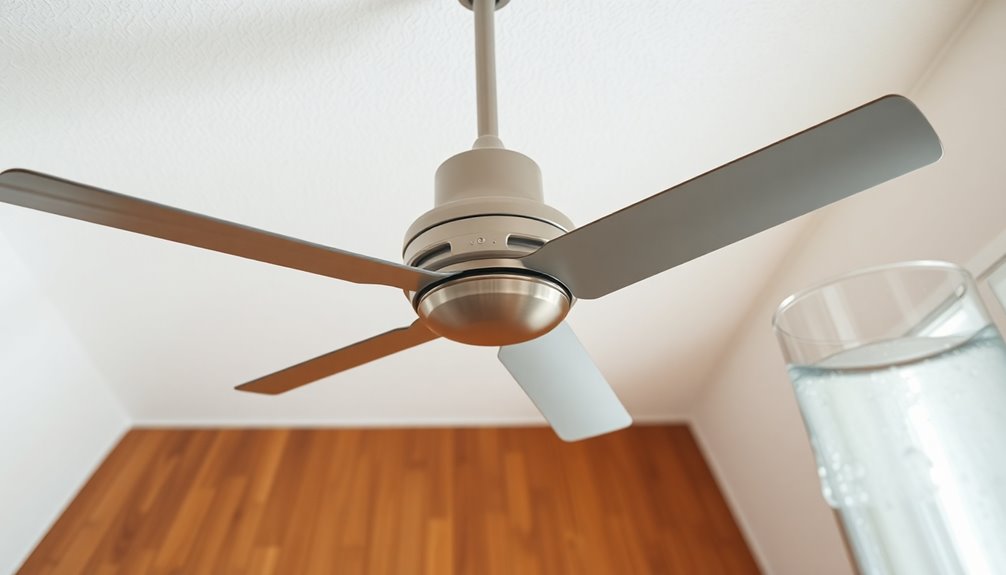
Ceiling fans are simple yet effective devices that create airflow by rotating their blades. This movement enhances evaporation from your skin, giving you a cooling effect without actually reducing humidity levels in the room.
During warm weather, you can set the blades to rotate counterclockwise, pushing cool air downward for improved comfort. This configuration helps you stay cool while maintaining the existing humidity.
In winter, reversing the blades to rotate clockwise allows the fan to redistribute warm air that rises to the ceiling. This helps maintain a comfortable temperature without adding moisture to the air.
By promoting air circulation, ceiling fans also prevent stagnant air, which can contribute to increased humidity levels and discomfort.
While ceiling fans won't remove moisture from the air, they can support other methods of humidity control by aiding in effective air dispersal.
You'll notice that by keeping the air moving, the perception of mugginess is reduced, making your indoor environment more pleasant.
Ceiling Fans and Air Circulation
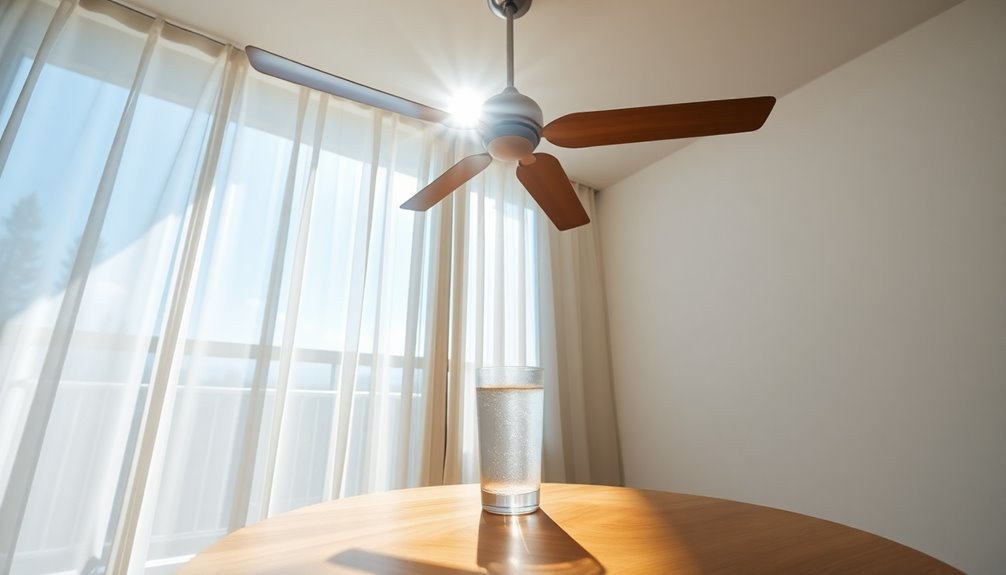
Enhancing air circulation with ceiling fans can considerably improve your indoor comfort. By creating a wind chill effect, ceiling fans help evaporate moisture from surfaces, effectively reducing the perceived humidity in your home. This consistent airflow prevents stagnant air, which often leads to increased humidity and discomfort.
When you run your ceiling fans alongside open windows, you facilitate cross-ventilation. This combination allows humid air to escape while fresh air circulates in, providing a revitalizing environment.
During warmer months, you should set your ceiling fan to rotate counterclockwise. This pushes cool air downward, enhancing evaporation rates on your skin and surfaces, further aiding in humidity control.
Regular use of ceiling fans maintains a balanced indoor environment by evenly distributing air throughout the room. This even distribution mitigates localized humidity build-up, ensuring that you feel comfortable no matter where you're in your space.
The Role of Evaporation
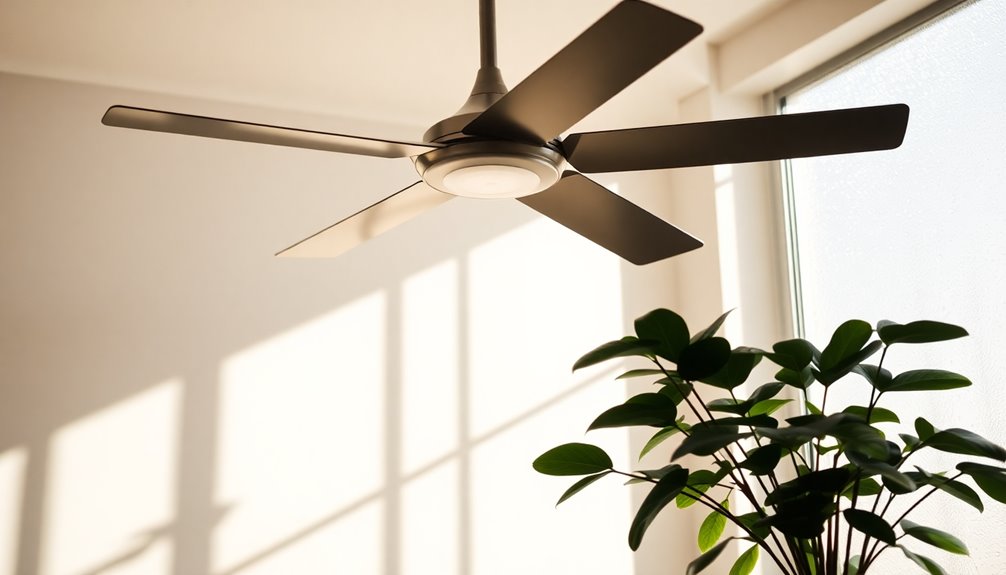
When it comes to creating a comfortable indoor environment, evaporation plays a significant role. Ceiling fans enhance air circulation, which greatly boosts the evaporation rate of moisture from your skin and surfaces. This process is essential because stagnant air can trap moisture, leading to a damp feeling that many find uncomfortable.
By increasing air movement, ceiling fans facilitate the drying of wet surfaces and skin, contributing to an overall reduction in perceived humidity. The wind chill effect created by a ceiling fan also gives you a cooling sensation, making those higher humidity levels feel more tolerable.
While it's noteworthy that ceiling fans don't directly remove humidity from the air, they do support the evaporation process, effectively lowering humidity levels indoors. The effectiveness of this evaporation can vary depending on several factors, including the air temperature, existing humidity levels, and the fan's speed setting.
Comparing Fans and Dehumidifiers
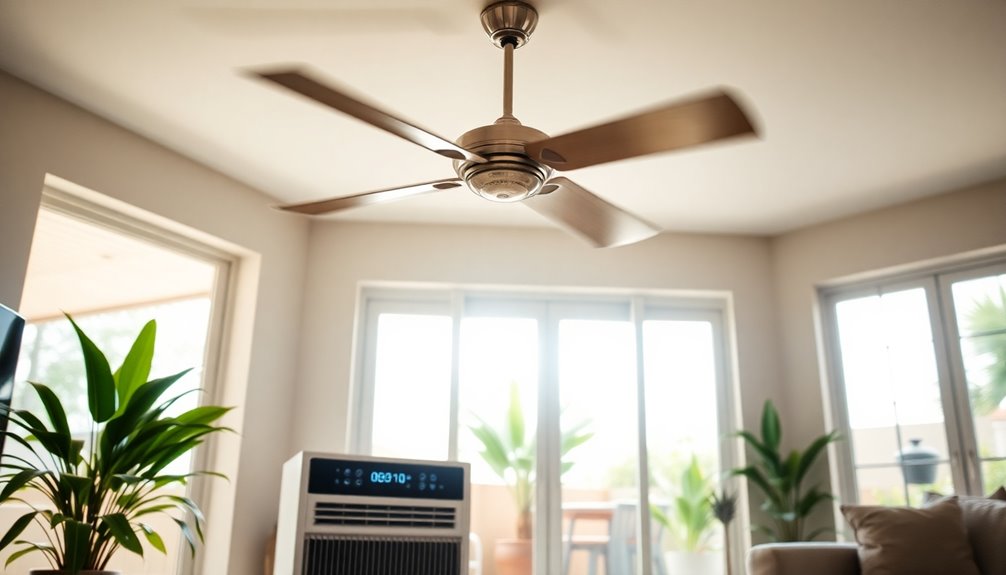
When it comes to managing indoor humidity, understanding the differences between ceiling fans and dehumidifiers is essential.
Fans circulate air to create a cooling effect, but they don't tackle moisture like dehumidifiers do.
Let's break down how each option works, their efficiency, and their cost-effectiveness to help you make an informed choice.
Fan Functionality Explained
Understanding the differences between ceiling fans and dehumidifiers is essential for effectively managing indoor comfort. Ceiling fans circulate air within your room, creating a wind chill effect that enhances comfort, but they don't directly remove humidity from the air.
On the other hand, dehumidifiers actively extract moisture, reducing indoor humidity levels considerably—by as much as 30-50%.
While ceiling fans can help make you feel cooler by improving air circulation, their impact on humidity is limited. They facilitate evaporation from surfaces but don't condense or remove moisture from the air, which is the primary function of a dehumidifier.
If you're dealing with high indoor humidity, relying solely on ceiling fans won't cut it.
To optimize your indoor environment, consider combining ceiling fans with dehumidifiers. This combination promotes airflow while effectively managing humidity levels, making your space more comfortable.
By understanding the distinct roles these devices play, you can create a balanced atmosphere that keeps you cool and dry.
Dehumidifier Efficiency Factors
Ceiling fans and dehumidifiers serve different purposes, and knowing how each operates can help you choose the right solution for your humidity issues.
While ceiling fans enhance air circulation and promote evaporative cooling, they don't remove excess moisture from the air. In contrast, dehumidifiers are specifically designed to extract humidity, making them far more effective at maintaining ideal humidity levels.
Here are some key dehumidifier efficiency factors to take into account:
- Room Size: Larger spaces may require more powerful units to effectively reduce humidity.
- Humidity Levels: High humidity environments will demand more from your dehumidifier, affecting its efficiency.
- Energy Rating: Opting for a unit with a good energy rating can guarantee effective moisture removal without excessive energy consumption.
A standard dehumidifier can remove 30 to 50 pints of moisture daily, depending on conditions. Additionally, regular maintenance and filter replacements are crucial for ensuring optimal dehumidifier performance and longevity.
Unlike ceiling fans, which only circulate air, dehumidifiers actively combat humidity.
For the best results, think about using both ceiling fans and dehumidifiers together, improving air movement while actively reducing humidity levels in your space.
Cost-Effectiveness Comparison
While you might consider ceiling fans a budget-friendly option for cooling your home, they don't tackle humidity like dehumidifiers do. When comparing cost-effectiveness, it's important to look beyond initial prices and consider long-term benefits, especially in areas with high humidity. Here's a breakdown of the costs associated with each option:
| Feature | Ceiling Fans | Dehumidifiers |
|---|---|---|
| Initial Cost | $50 – $300 | $150 – $400 |
| Operating Cost (per hour) | $0.01 – $0.02 | $0.25 – $0.50 |
| Humidity Reduction | Minimal | 30% – 50% |
| Maintenance Cost | Low | Moderate (filters) |
| Long-term ROI | Low in high humidity | High in high humidity |
Ceiling fans may be cheaper to run, but they don't effectively reduce humidity. In contrast, dehumidifiers can transform your living space by lowering humidity levels, which helps prevent mold and structural damage. Ultimately, in environments with persistent high humidity, investing in a dehumidifier yields greater long-term savings and comfort.
Optimal Fan Usage Strategies
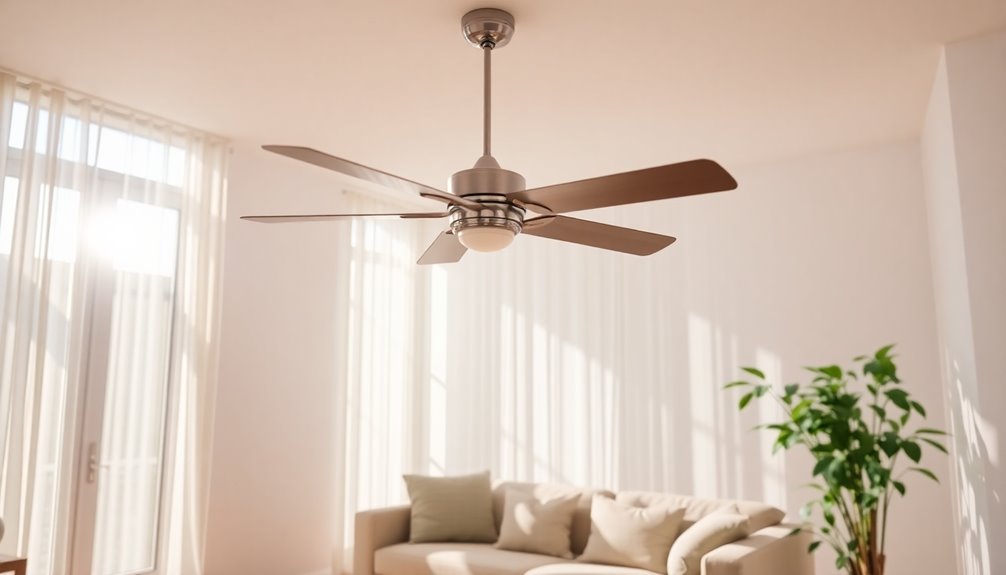
Often, effective fan usage can dramatically improve your indoor comfort, especially in humid environments. While ceiling fans don't directly reduce humidity, they enhance air circulation, making moisture feel less oppressive.
Here are some ideal strategies for using your ceiling fans:
- Run your fan counterclockwise during warm weather to circulate cooler air downward, aiding in moisture evaporation.
- Use fans in tandem with open windows to create better cross-ventilation, allowing humid air to escape from your living space.
- Keep your ceiling fans on consistently in humid areas like kitchens and bathrooms, where excess moisture from cooking and bathing can accumulate.
Additionally, don't forget that regular cleaning of your fan blades is vital. Dust can trap moisture and hinder the fan's ability to create a comfortable atmosphere. Lastly, utilizing energy-saving features in your home can complement the cooling effects of ceiling fans by reducing overall energy consumption.
Limitations of Ceiling Fans
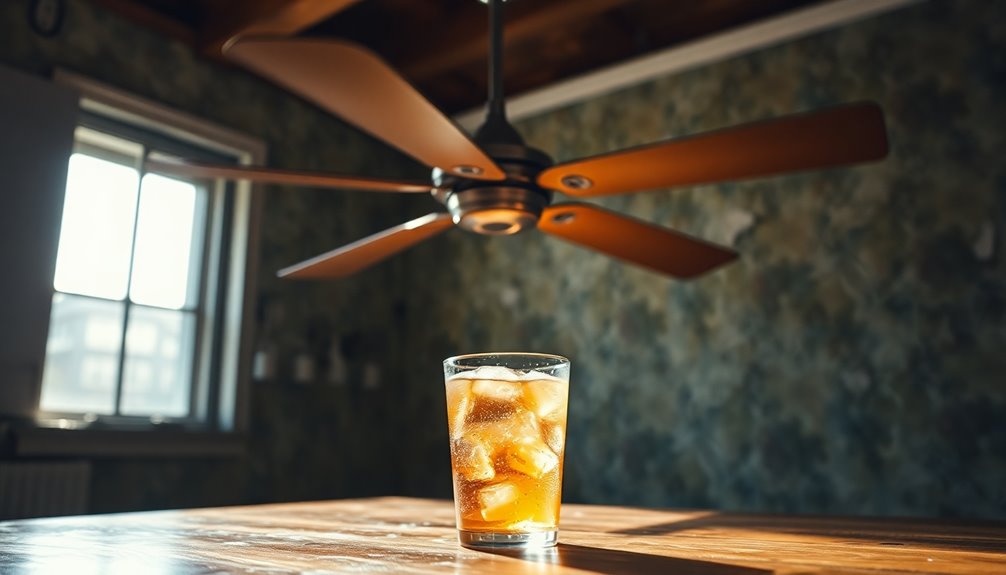
While ceiling fans are great for circulating air, they don't actually remove moisture from the environment.
This means they aren't a replacement for dehumidifiers or air conditioning when it comes to managing humidity levels.
In fact, in very humid conditions, a ceiling fan mightn't provide the cooling relief you expect.
Limited Moisture Removal Efficiency
Ceiling fans are popular for creating a comfortable atmosphere, but their ability to reduce humidity is limited. While they improve air circulation and can help you feel cooler, they don't actually remove moisture from the air. Instead, they enhance evaporation from your skin and surfaces, which can make the environment feel less humid.
However, in highly saturated conditions, their impact diminishes considerably.
Here are a few key limitations to take into account:
- Ceiling fans can't lower actual humidity levels like dehumidifiers or air conditioners.
- They may lead to moisture accumulation on fan blades, causing maintenance issues.
- Proper ventilation and moisture removal techniques are still necessary in humid environments.
Ultimately, if you're relying on ceiling fans to combat humidity, you'll find their effectiveness is quite limited. They may redistribute air, but they won't change the moisture content in the room.
Not Suitable for Cooling
Relying on ceiling fans for cooling can be misleading, as they don't actually lower the temperature of the air. Instead, they circulate it, which might give you a sense of relief but doesn't address the underlying humidity levels. While you may feel cooler due to increased air movement, the fan doesn't change the air quality or humidity in your home.
In high humidity environments, the fans can promote evaporative cooling from your skin, but they only offer temporary comfort. When the air is already saturated with moisture, this effect diminishes, leaving you uncomfortable.
If you depend solely on ceiling fans for humidity control, you risk creating stagnant air, as they won't remove excess moisture from your environment.
To maintain a comfortable atmosphere, it's crucial to combine ceiling fans with proper dehumidification methods. This approach guarantees that you enhance your air quality while effectively managing humidity levels.
Don't be fooled into thinking that ceiling fans are a complete solution for cooling; they're best used in conjunction with other systems to achieve peak comfort in your space.
Cannot Replace Dehumidifiers
Fans can create a pleasant breeze, but they can't replace dehumidifiers when it comes to managing indoor humidity. While ceiling fans circulate air and provide a cooling effect, they don't remove moisture from the air. This limitation makes them ineffective for reducing humidity levels on their own.
Consider the following points:
- Ceiling fans enhance evaporation from your skin but don't change the absolute humidity in a room.
- Whole-home dehumidifiers actively extract moisture, greatly lowering indoor humidity levels.
- Relying solely on ceiling fans won't address mold growth or structural damage caused by excess humidity.
For ideal humidity control, it's best to use ceiling fans in conjunction with a whole-home dehumidifier.
While fans improve comfort during humid conditions, they simply can't tackle humidity issues like a dehumidifier can. By combining both, you can enjoy a more comfortable and healthier indoor environment without worrying about moisture-related problems.
Additional Humidity Control Methods

When it comes to managing indoor humidity, a variety of effective methods can enhance your home's comfort.
Using exhaust fans in kitchens and bathrooms is a great way to eliminate humid air created during cooking and bathing. This prevents moisture buildup that can lead to discomfort and potential mold growth.
You might also consider installing a whole-home dehumidifier that integrates with your HVAC system. This guarantees consistent humidity levels throughout your house, making your air feel fresher.
Additionally, simple household practices can make a big difference—covering pots while cooking and drying clothes outdoors can markedly lower indoor humidity.
Regular maintenance of your HVAC systems and air conditioners is essential too. It not only improves cooling efficiency but also enhances their ability to manage humidity levels effectively.
Finally, natural desiccants like baking soda or charcoal briquettes can absorb moisture in targeted areas, providing an inexpensive temporary solution for humidity control.
Importance of Proper Ventilation
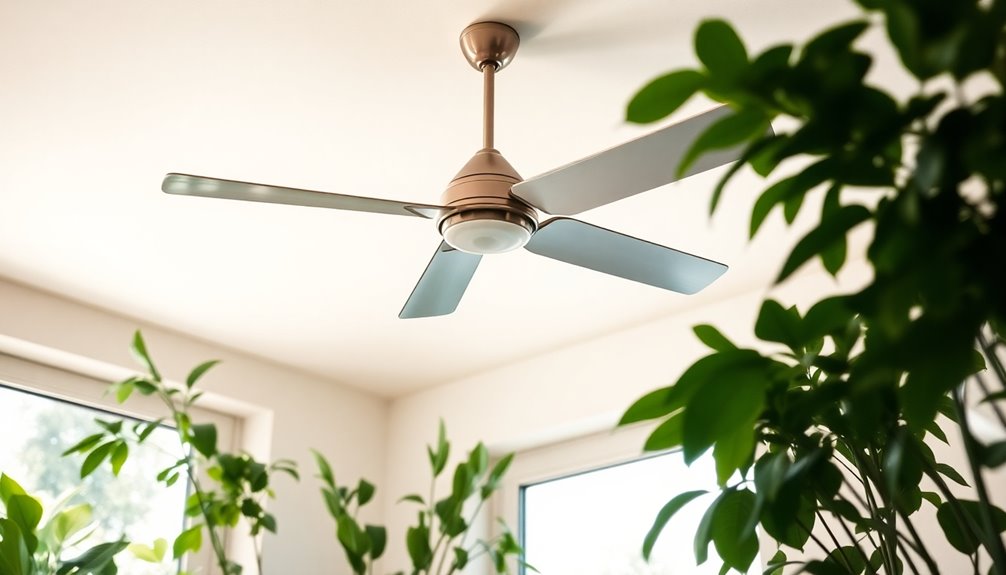
Proper ventilation is essential for maintaining a healthy indoor environment and controlling humidity levels. Without it, you risk the buildup of moisture, leading to mold growth and respiratory problems.
By ensuring proper ventilation, you can effectively manage humidity and improve air quality in your home. Here are some strategies to contemplate:
- Use exhaust fans in kitchens and bathrooms to expel moist air.
- Open windows on opposite sides of your home for cross-ventilation.
- Regularly monitor indoor humidity levels for ideal ranges.
Ceiling fans also contribute to air circulation, helping to evaporate moisture from surfaces, which can greatly reduce your perception of humidity. Effective reduction of allergens such as dust and pollen is also an important benefit of maintaining a well-ventilated space. Additionally, decluttering spaces can enhance air flow, allowing for better circulation and further mitigating humidity issues. Regular use of vacuum cleaner attachments can also aid in maintaining low allergen levels by removing dust more effectively.
When air circulates freely, it not only keeps your indoor space comfortable but also prevents stagnant air that can trap humidity. Ideally, you want to maintain humidity levels between 30% and 50%. Regular use of air purifiers can also help in capturing harmful pollutants and improving overall air quality.
Incorporating these ventilation practices can make a noticeable difference in your indoor environment.
Enhancing Comfort With Ceiling Fans

In the summer months, ceiling fans can greatly enhance your comfort by creating an invigorating wind chill effect. This effect helps your body feel cooler, even in warm, humid conditions, without actually lowering the room temperature. Additionally, high-end ceiling fans often feature energy-efficient motors that maximize airflow while minimizing electricity consumption.
By increasing air circulation, ceiling fans prevent stagnant air that can lead to discomfort and increased humidity levels in your space. Furthermore, using smart technology integration can help you monitor and control your ceiling fan's operation for optimal comfort and efficiency. Commercial grade heat pumps can also work in tandem with ceiling fans to further improve climate control in larger spaces. Moreover, incorporating energy-efficient designs can contribute to a greener lifestyle while enhancing your overall comfort.
Using ceiling fans alongside your air conditioner can boost energy efficiency too. You can set your thermostat a bit higher while still feeling comfortable, as the fans help distribute cool air more effectively.
During warmer months, make certain your ceiling fan rotates counterclockwise to push cool air downward, enhancing that revitalizing breeze.
Don't forget about maintenance! Regularly cleaning your ceiling fan blades guarantees they operate at peak performance, maximizing air circulation and comfort in humid environments. Additionally, using high CFM ratings in ceiling fans can further improve airflow and reduce humidity levels.
Incorporating ceiling fans into your home not only enhances your comfort but also complements your air conditioning, making every season more enjoyable.
Frequently Asked Questions
Do Ceiling Fans Make the Air More Dry?
Ceiling fans don't make the air drier; they just circulate it.
While you might feel cooler as the fan moves air across your skin, this doesn't actually lower the moisture in the air. Instead, it enhances evaporation, which can give you a revitalizing sensation.
If you want to reduce humidity, you'll need to use a dehumidifier or air conditioning, as fans alone won't affect the moisture levels in your space.
How Do I Lower the Humidity in My Room?
To lower the humidity in your room, start by using a portable dehumidifier to actively remove moisture from the air.
You can also run exhaust fans in kitchens and bathrooms to eliminate excess humidity.
Open windows on opposite sides to create cross-ventilation, and run ceiling fans counterclockwise to improve air circulation.
Finally, limit activities that produce steam, like long hot showers or boiling water, to keep humidity levels in check.
Is It Good to Leave Ceiling Fans on All the Time?
Leaving ceiling fans on all the time can be beneficial for air circulation and comfort, but it's important to balance that with energy consumption.
If you're in a room, having the fan running creates a pleasant breeze, making you feel cooler. However, remember to turn it off in unoccupied spaces to save energy.
While it won't directly lower humidity, it helps evaporate moisture, giving you a drier sensation in humid conditions.
Does a Fan Help Dehumidify a Room?
Did you know that a ceiling fan can create a wind-chill effect that makes the air feel up to 10 degrees cooler?
While fans don't directly dehumidify a room, they enhance air circulation, helping moisture evaporate more quickly from surfaces.
This can make your space feel less sticky and more comfortable.
Pairing your fan with exhaust fans in humid areas can further improve the situation, making your indoor environment feel fresher.
Conclusion
In the battle against humidity, ceiling fans can be your trusty allies, circulating air and creating a cooling effect. Yet, they're not a replacement for dehumidifiers, which actively remove moisture from the air. While fans offer comfort and a breeze, they can't truly combat the oppressive weight of high humidity. Embrace the synergy of both tools, and you'll find the perfect balance between comfort and control, transforming your space into a haven of relaxation.


